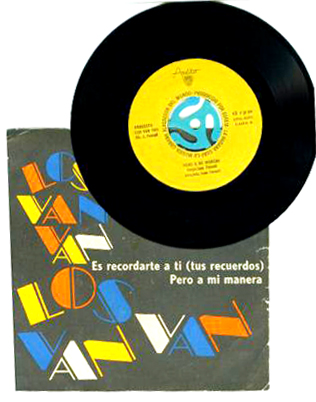Indice - Table of contents
Lo Nuevo[hide]
Grupos: Ritmo Oriental : 1988 - Vol. IX - 30 a...
Musicos: Rafael Paseiro Monzón
Musicos: Dennis Nicles Cobas
Musicos: Jiovanni Cofiño Sánchez
Musicos: Yasser Morejón Pino
Fotos: Tom Ehrlich : 2024 Monterey Jazz, P...
Resenas: Vacilón Santiaguero (Circle 9 ...
Staff: Bill Tilford
Fotos: Tom Ehrlich : 2024 Monterey Jazz, P...
Fotos: Tom Ehrlich : 2024 Monterey Jazz Fe...
Fotos: Tom Ehrlich : testing 123
Grupos: Pupy y los que S... : Discography - 1995- F...
Reportes: From The St... : Cubadisco 2...
Reportes: From The St... : Jazz Plaza ...
Fotos Del Día [hide]
The Roots of Timba - Part II - Los Van Van: The Singles

| EGREM # | A-side | B-side |
| EPA-6281 | Aquí se enciende la candela | Mis dudas |
| EPA-6285 | Pero a mi manera* | Es recordarte a ti |
| EPA-6332 | Y que se sepa | Y me basta con pensar |
| EPA-6333 | Pero qué falta de respeto* | Qué decir del dolor |
| EPA-6334 | Ponte para las cosas* | No puedo vivir |
| EPA-6472 | Ana | Uno solo fuerte |
| EPA-6473 | Chirrín chirrán | La habana joven |
CD availability: LVV Vol. II "Tránsito" "Rosetta Stone" bootleg
*Those with asterisks were recorded once in Havana for the single and re-recorded in Spain for Tránsito
1972? - Los Van Van - Pero a mi manera (EPA-6285A)
xx0x 0xxx 0xx0 xxx0 2-3 rumba clave
xxx0 xxxx xxx0 xxxx kick
xxxx xxxx xxxx xx0x (pickup)
0xxx xx0x xxx0 xx0x MIDI example
bass: Juan Formell - drums: Changuito
source: Los Van Van, Vol. II
notes: One can only imagine how the opening of Pero a mi manera must have sounded to Habaneros when it debuted on Radio Taíno in 1971 or 72. That excerpt is from the original single. Here's the same passage from the album version which we'll use for the rest of the excerpts - recorded in Spain, probably in early 1974. The introduction juxtaposes Changuito's swirling new rhythms and against a static harmony consisting of a single suspended triad which lasts 4 claves and continues into beginning of a strange and beautiful cuerpo which marks Formell's graduation from copying North American pop hooks to creating new ones of his own. The second cuerpo section uses a much more typical chord progression, but before it can become predictable, the voices come out of nowhere with a cathartic flash of inspiration.
With this song, Formell hit his stride as a songwriter. The hooks keep pouring out effortlessly as the beginning of the bridge is set against a bass tumbao whose rhythm is identical to the first half of Paulito FG's 1997 classic, Con la conciencia tranquila (0xx0 0xxx x0x0 x00x). This is followed by a Beatlesque string passage, another great melodic hook, the return of the cathartic choral figure, and then, suddenly, 5 full claves of unaccompanied percussion (entire bridge).
Perhaps the most unusual and original Cuban cuerpo since Tintorera ya llegó is followed by an equally striking montuno section with so many interesting features that it's easier to describe them in a list:
1) The coro itself is a powerful and original hook.
2) While it lasts only 2 claves, it manages to convincingly modulate back and forth between the keys of C and A, creating an unresolved tension that allows it to be repeated over and over like the encore vamp of a stadium rock concert. In fact, from the point the coro enters, the addictive chord progression repeats until the song fades out.
3) There are no guías! In these early recordings, Formell avoided the call and response vocals that are so central to almost all Latin music.
4) As the coro is repeated, the orchestration changes in a way that looks forward to the ultimate goal of our 3-volume study: the "gear changes" of timba. Just as the introduction holds the harmony static in order to showcase variations in Changuito's drumming, the montuno section repeats the coro 12 times and creates interest with the following rhythmic scheme:
[audio example]
12 claves - all instruments playing normal songo accompaniment parts
4 claves - strings and keyboards drop out; percussion & bass continue
4 claves - keyboards double bass (later we'll call this "motivo" gear)
4 claves - strings double keyboards and bass
4 claves - motivo figure continues - coro stops - percussions plays bloques
8 claves - back to normal songo with modified coro
fade - flute solos over same chord progression
The B-side of Pero a mi manera was Es recordarte a ti, a bolero which can be found on the "Rosetta Stone" compilation described above. It sounds like a cross between and old-fashioned Cuban bolero and a Stax/Volt ballad, but if you listen with a discerning ear, you'll hear details in the bass playing and harmonies that shed light on Formell's master plan to reinvent not only up-tempo dance music, but ballads as well.





















